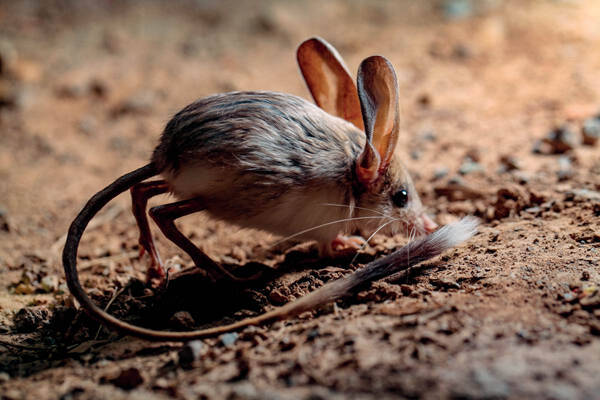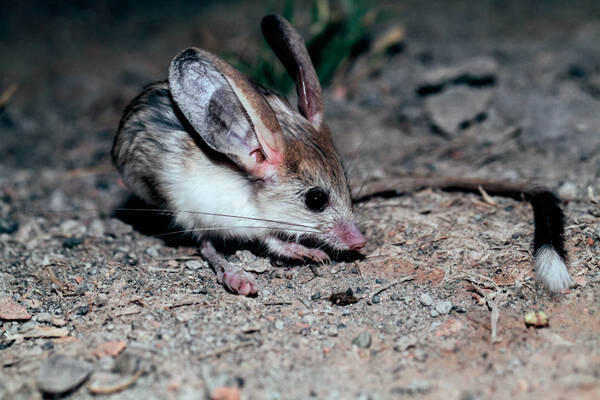Euchoreutes naso
IUCN
LCBasic Information
Scientific classification
- name:Euchoreutes naso
- Scientific Name:Euchoreutes naso,Long-eared Jerboa,
- Outline:Rodents
- Family:Rodentia Jerboa L.Jerboa
Vital signs
- length:80-90mm
- Weight:30-40g
- lifetime:
Feature
It is small in size, with large and long ears; its tail is nearly twice as long as its body, and there is a spike of long hair at the end of its tail, which is black at the base and white at the tip.
Distribution and Habitat
In China, it is distributed in Inner Mongolia, Xinjiang, Ningxia, Qinghai and Gansu. Abroad, it is distributed in Mongolia.
Long-eared jerboa inhabits desert areas, especially sandy deserts, salt meadows and gravel deserts.
Appearance
The individual is small, with a body length of 80-90mm. The ears are huge, about half the body length, 40-50mm, and can reach the waist when folded back. The hind legs are three times the length of the front legs, averaging about 45mm. Good at jumping. The fur on the back is sandy gray, sometimes dyed with gray tones, and the ventral side from the chin (ventral side of the mouth) to the base of the tail is pure white. The tail is long, nearly twice the length of the body, 140-180mm. The tail shaft is covered with longer hair, making the tail shaft appear thicker. The tuft of hair at the end of the tail is large, the tip of the tail is white, the middle is black, and the beginning of the tail hair expansion is a narrow white section. There are 5 toes on the hind feet, but the toes on both sides are very small.
Details
The long-eared jerboa belongs to the subfamily Euchoreutinae, a single genus and a single species. There is no dispute about its taxonomic status, with 3 subspecies, 2 of which are in China. It inhabits deserts and sandy desert steppes. It is widely distributed, with a large population in sparse poplar forest sands and xerophytic reed dunes. The peak breeding season is from May to June, with 2 to 6 pups per litter.

Long-eared jerboas mostly prefer to be active at night, and their sensory channels include vision, touch, hearing, and chemical perception. The species is insectivorous and often preys on flying insects by using sound to locate them and then quickly jumping into the air. The groups in China are more herbivorous. They also use their good hearing to avoid predation by nocturnal predators, and their keen hearing also suggests that they may use sound or vibrations to communicate. They also take sand baths, which is usually a way of communicating using chemicals. The abundant hair on the hind legs is conducive to jumping in the desert environment, and it can jump more than 1 meter high.

Mating usually occurs within a short period of time after waking up from hibernation. Each female individual reproduces twice in the summer, and the reproductive age is between 2 and 6 years old. The gestation period is between 25 and 35 days, and the number of pups per litter is 2 to 6.
Given its widespread distribution, presumed abundance, and occurrence in some protected areas, it is unlikely to be declining at a rate that would even qualify it for inclusion in the threatened category.








